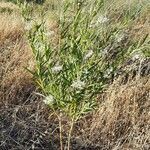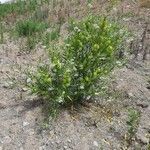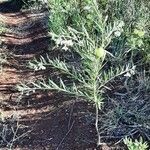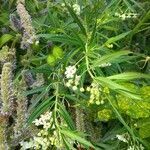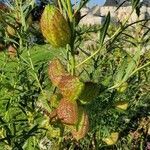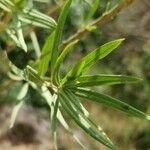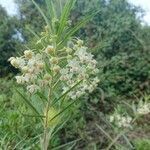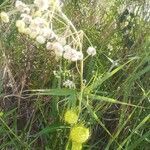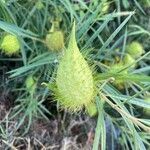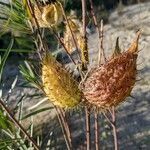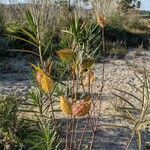Much-branched shrub to c. 2 m high, with slender puberulent stems. Lvs opposite or alternate, sessile or subsessile, 5.5-12 × 0.5-1 cm, linear-lanceolate, glabrous except for midrib beneath and sometimes scattered hairs above and on margins, sharply acute. Cymes axillary; fls few to fairly numerous. Peduncles and pedicels usually 1-2 cm long, densely puberulent. Calyx lobes 3.5-4 mm long, linear-lanceolate, densely puberulent. Corolla lobes 6-9 mm long, ovate-elliptic; margins white, ciliate towards apex at least on one side. Corona scales c. 4 mm long, fleshy, hooded, greenish white, incurved, with a lateral tooth or auricle on each side. Follicles 4-6 cm long, broad-ovoid, tapering to a beak, inflated, ± puberulent, covered with soft, subulate bristles 7-10 mm long.
Erect, annual to biennial shrub to 2 m high. Leaves sessile; lamina lanceolate, to 12 cm long, to 1.5 cm wide, cuneate at base, acute; secondary veins 12–14 each side of midrib; colleters absent. Inflorescence umbelliform. Flowers 7–10 mm long, 11–15 mm diam.; pedicels 15–20 mm long. Corolla cream to greenish cream; lobes lanceolate-ovate, 7–8 mm long. Staminal corona 2–4 mm long; lobes 2.4–3 mm long, 2–2.4 mm wide, with upper proximal ends produced into 2 long recurved teeth. Follicles ovoid at maturity, 4–6 cm long, 2–3.5 cm wide, acuminate.
Shrubs to 2 m tall. Stems puberulent. Leaves opposite, short petiolate; leaf blade linear or linear-lanceolate, 6-10 cm × 5-8 mm, glabrous, apex acuminate, margin revolute; lateral veins inconspicuous. Cymes 4-6 cm. Flower buds globose. Sepals lanceolate, puberulent. Corolla white; lobes broadly ovate or elliptic, reflexed, ciliate. Corona lobes dark, hood-like. Follicles inflated, 5-6 × ca. 3 cm, apex acuminate, long beaked, spines of pericarp soft, ca. 1 cm. Seeds ovate; coma ca. 3 cm. Fl. summer. 2n = 22.
A herb or small shrub. It can grow each year from seed or keep growing from year to year. It grows 2-4 m high. It has milky latex. The leaves are in pairs and are hairy. The leaf blade is 4-12 cm long by 1 cm wide. They are narrowly sword shaped. The flowers occur in groups or 4-7 in a nodding group along the stalk. They are hairy. The fruit are follicles. They are spindle shaped and 5-8 cm long by 2-3 cm wide. The seeds are dark and have cotton like hairs attached.
Soft shrub branching mainly from base, 1-3 m; sap milky. Leaves opposite, linear to oblanceolate, tapering gradually below. Flowers cream-coloured. Fruits inflated, ovoid-acute.
